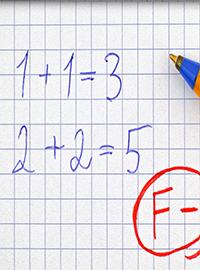| Student Performance Suffers Unprecedented Decline, Confirming Need for School Choice |
 |
|
By Timothy H. Lee
Thursday, October 27 2022 |
Are you better off today than you were two years ago? Paraphrasing Ronald Reagan’s pivotal 1980 debate query, that question looms large with November’s midterm elections already underway. From inflation to crime to international relations to energy to almost every other realm of our lives, the answer is an unequivocal “no.” This week brought perhaps the most unsettling response to that question yet, however, as the Education Department released student test results showing that our nation’s children certainly aren’t better off. According to the 2022 National Assessment of Educational Progress (NAEP), the nation suffered an unprecedented plummet in learning performance in what’s known as the “Nation’s Report Card,” including the first declines in math scores ever recorded: In 2022, the National Center for Education Statistics (NCES) conducted a special administration of the NAEP long-term trend (LTT) reading and mathematics assessments for age 9 students to examine student achievement during the COVID-19 pandemic. Average scores for age 9 students in 2022 declined 5 points in reading and 7 points in mathematics compared to 2020. This is the largest average score decline in reading since 1990, and the first ever score decline in mathematics. That depressing news arrives less than a week after American College Testing (ACT) average scores plummeted to a record low: The ACT has released the average scores for the class of 2022, which show a precipitous drop in national averages. The class of 2022 had an average composite score of 19.8 – down from 20.3 in 2021 – making this the first time since 1991 that the average score has fallen below 20. This number offers a more comprehensive picture than in years past, as a record 60% of students took the test in 2022, compared to 27% in 2015. The decline is consistent with dropping averages in other standardized tests across age groups, including the SAT, which saw a 10-point drop, and the NAEP Age 9 Assessment, which yielded the lowest scores in math and reading in decades. In ACT’s official press release, CEO Janet Godwin added that, “The magnitude of the declines this year is particularly alarming, as we see rapidly growing numbers of seniors leaving high school without meeting the college readiness benchmark in any of the subjects we measure.” She also emphasized, “These declines are not simply a byproduct of the pandemic.” She’s absolutely right. These unprecedented declines indict our nation’s educational establishment, even as it receives ever-higher amounts of taxpayer subsidy. This wasn’t merely some mundane continuation of a gradual decline, but a precipitous drop after school lockdowns and forcible remote instruction continued long after children’s diminished Covid risk level became clear. It all offers yet another stark reminder of just how costly educational command and control according to the wishes of teachers’ unions and arrogant officials like Anthony Fauci can be. It also explains why American public trust in public schools has fallen to its own record low, according to Gallup. Today, only 28% of Americans express trust in the public school system, down from 62% in 1975, and down 13 points from 41% in 2020. That distrust was well-earned and well-deserved. Now the question becomes whether fed-up Americans will insist on change. So far, the signs are encouraging. In an otherwise difficult election year for Republicans, Ron DeSantis won the tight 2018 Florida governor’s race due in significant part to his support for school choice. Today he stands poised to be comfortably reelected. In Arizona, which offers a nationwide educational voucher model under the leadership of outgoing Governor Doug Ducey, school choice has proved wildly popular with actual students and parents themselves, as even the left-leaning Arizona Republic acknowledged: Over 10,000 applications for universal school vouchers poured in over the course of less than a week, according to the Arizona Education Department. As of Wednesday, the state had received nearly 22,500 universal eligibility applications, the Education Department said on Twitter. Arizona started accepting universal eligibility applications in mid-August, and the program was officially greenlit last week. Those numbers show significant interest in the expanded school choice voucher program, now the biggest of its kind in the nation. Even far-left union-captive Illinois Governor J.B. Pritzker just backtracked on his longstanding opposition to a statewide school choice program, which he previously vowed to terminate. As accumulating data confirm the disastrous effect of excessive school closures and educational conformity on our nation’s children, the parental backlash in favor of greater school choice is welcome. Whatever the merits of different educational alternatives, the choices should be made by parents and students with skin in the game, not government officials and their teachers’ union overlords. |
Related Articles : |
























